CTE in MySQL
Overview
Common Table Expressions (CTEs) are a powerful feature in MySQL that allows developers to define temporary named result sets within a SQL statement. CTEs can be used to simplify complex queries, traverse hierarchical data structures, and improve code readability. The WITH clause is used to define CTE in MySQL, and developers can create self-contained modules that can be reused across multiple queries. In addition to their modularity and readability benefits, CTEs can also improve query performance and reduce the need for subqueries. Overall, CTE in MySQL is a valuable tool for developers working with MySQL databases, offering a flexible and efficient way to work with complex data.
Introduction to Common Table Expression (CTE) in MySQL?
A Common Table Expression (CTE) is a temporary named result set that is defined within the scope of a single SQL query. It allows you to write complex queries in a more readable and maintainable manner, by breaking them down into smaller, logical steps. CTEs can be used in MySQL with the "WITH" keyword, followed by the name of the CTE and the SELECT statement that defines it. Once a CTE is defined, it can be referenced multiple times within the same query.
One of the main benefits of using CTEs is that they allow you to create recursive queries, which are queries that reference themselves. This can be useful for tasks such as generating hierarchical data or finding the shortest path between nodes in a graph. CTEs can also be used to simplify the syntax of complex joins, to create derived tables that can be used within other queries, or to improve query performance by reducing the number of times that a subquery needs to be executed.
MySQL CTE Syntax
The basic syntax for creating a Common Table Expression (CTE) in MySQL is as follows:
The syntax begins with the "WITH" keyword, followed by the name of the CTE, which can be any valid identifier. This is followed by the "AS" keyword and a SELECT statement that defines the result set for the CTE. The SELECT statement can include any valid SQL query, including joins, subqueries, and aggregate functions.
Once the CTE has been defined, it can be referenced in the main query by using its name in the FROM clause. In the Syntax above, the CTE is referenced in the main query by selecting all columns from "cte_name". It is important to note that the CTE must be defined before it is referenced in the main query. This means that the "WITH" clause must come before the "SELECT" clause in the SQL statement.
It is also possible to define multiple CTEs within the same query, by separating each CTE definition with a comma. For example:
In this example, two CTEs are defined: "cte1" and "cte2". The CTEs are then referenced in the main query by joining them on a common column and selecting all columns from both CTEs.
MySQL Recursive CTE Syntax
MySQL Recursive Common Table Expressions (CTEs) is a powerful feature that allows you to define a CTE that refers to itself. Recursive CTEs can be used to traverse hierarchical data structures, such as trees or graphs, and perform operations on each level of the hierarchy.
The syntax for creating a recursive CTE in MySQL is similar to that of a regular CTE, with the addition of a UNION ALL operator that allows the CTE to refer to itself. Here is an example of a simple recursive CTE in MySQL:
In this example, the CTE "cte_name" selects all records from "table_name" where "parent_id" is NULL. It then uses a UNION ALL operator to join the result set with a SELECT statement that refers to the CTE itself. This SELECT statement joins "table_name" with "cte_name" using the "parent_id" and "id" columns, respectively.
The recursive CTE continues to refer to itself until no more records are returned, at which point the result set is returned to the main query. The main query selects all columns from "cte_name" to display the complete hierarchical data structure. It is important to note that recursive CTEs must have a base case that terminates the recursion. In the example above, the base case is defined by the WHERE clause in the first SELECT statement, which selects only records where "parent_id" is NULL. Without this base case, the recursive CTE would continue to refer to itself indefinitely, resulting in an infinite loop.
MySQL CTE Examples
An example of how Common Table Expressions (CTEs) can be used in MySQL:
Suppose you have a sales table with columns "product_name", "sales_date", and "revenue". You want to calculate the total revenue for each product over the past 30 days, as well as the percentage change in revenue compared to the previous 30-day period. You can use a CTE to calculate these metrics:
The following commands can be used to create the table:
The following commands can be used to insert data into the table:
Table: sales
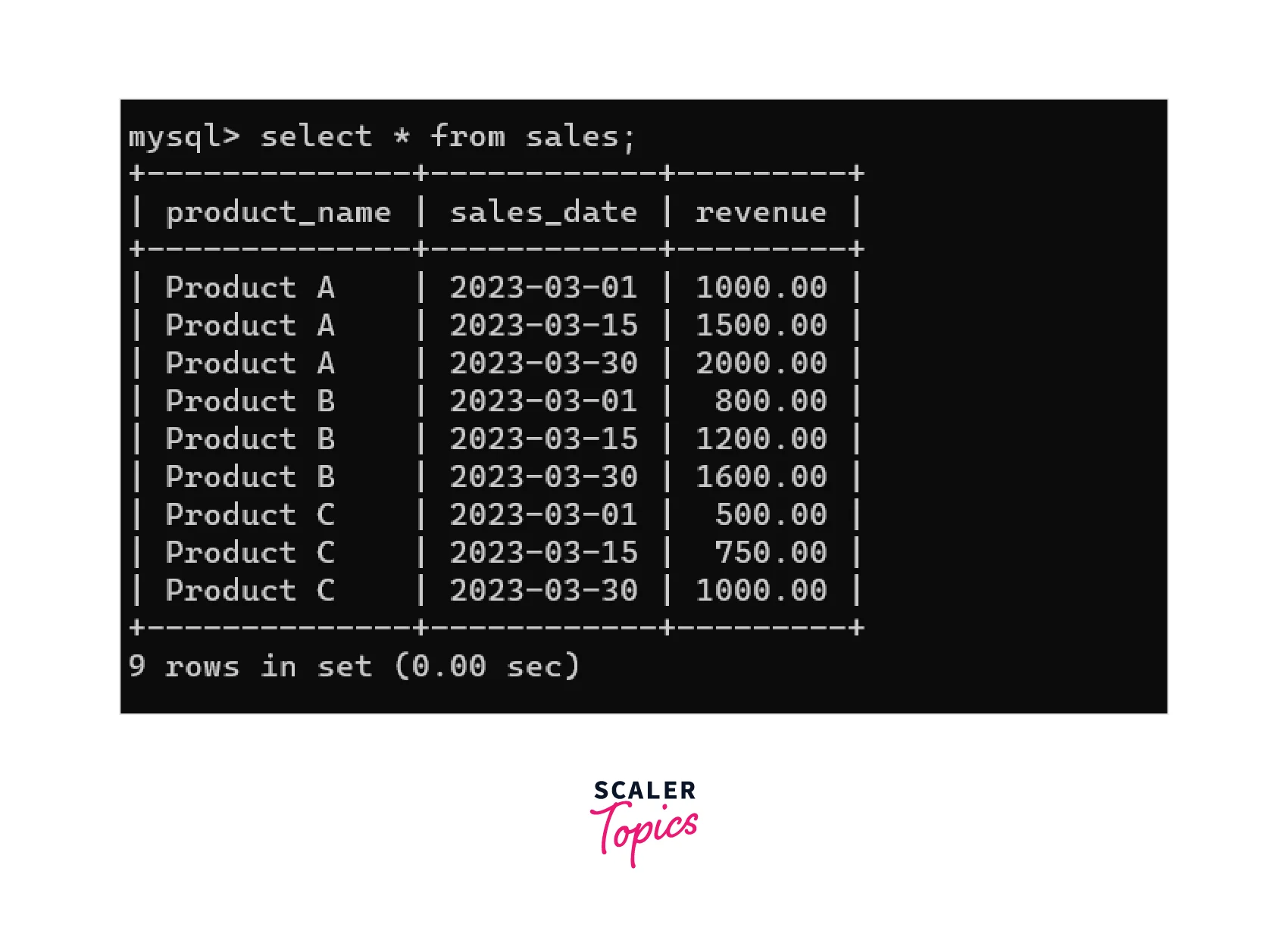
The Image depicts the table data of the following table sales.
Query -
Output -
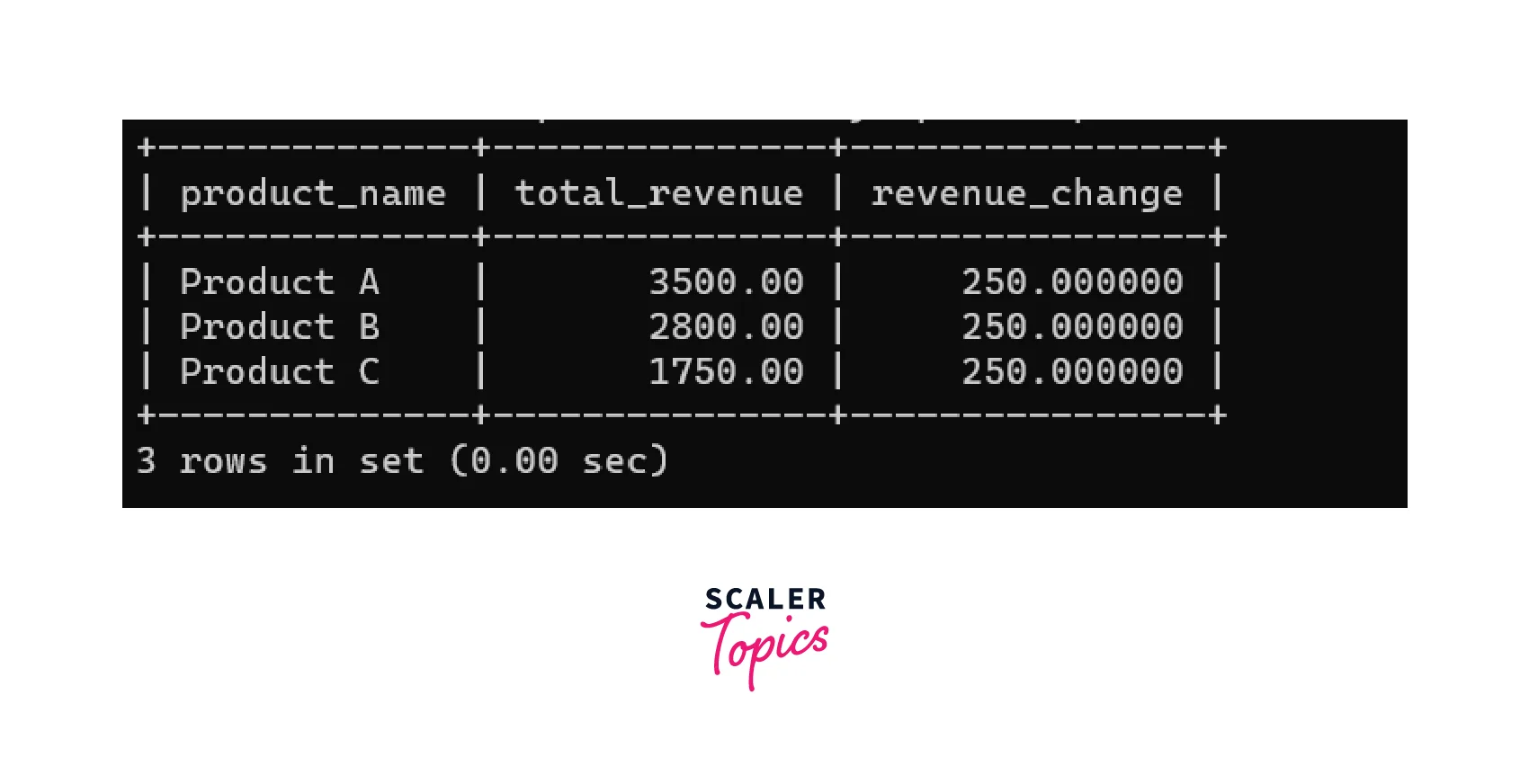
This CTE first calculates the total revenue for each product over the past 30 days and stores the result in a CTE called "sales_last_30_days". It then calculates the total revenue for each product over the previous 30-day period and stores the result in a CTE called "sales_previous_30_days". The main query joins these two CTEs on the "product_name" column and calculates the percentage change in revenue.
The More Advanced MySQL CTE Example
An example of more advanced Common Table Expressions (Recursive CTEs) in MySQL:
Suppose you have a database with a table called "sales" that contains sales data for a company. The "sales" table has columns for "order_date", "product", "quantity", and "revenue".
You want to create a report that shows the total revenue generated by each product, broken down by month. However, you also want to include a column that shows the percentage of total revenue generated by each product, based on the revenue generated by all products.
The following commands can be used to create the table:
The following commands can be used to insert data into the table:
Table - sales
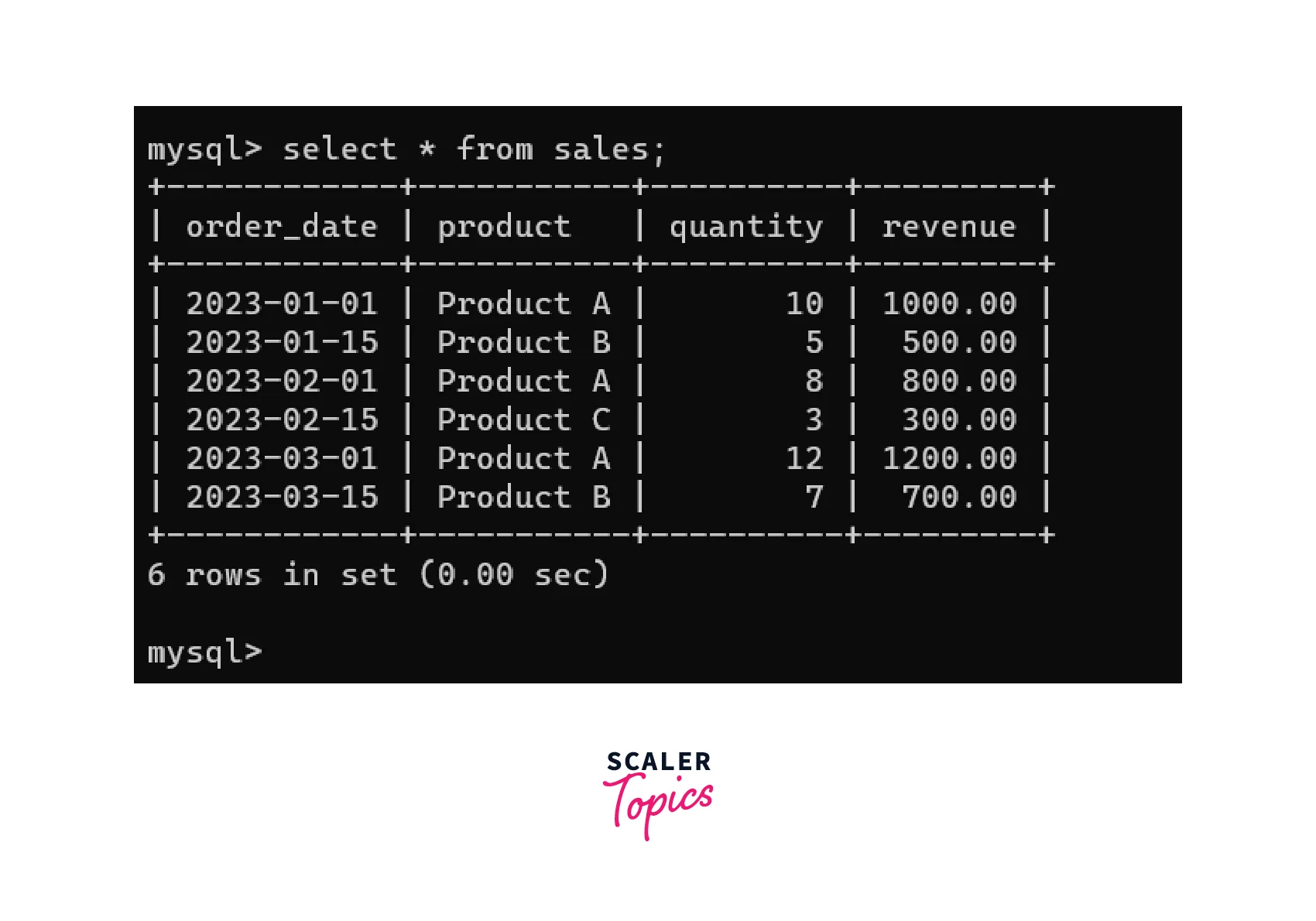
The Image depicts the table data of the following table sales.
Query -
Output -
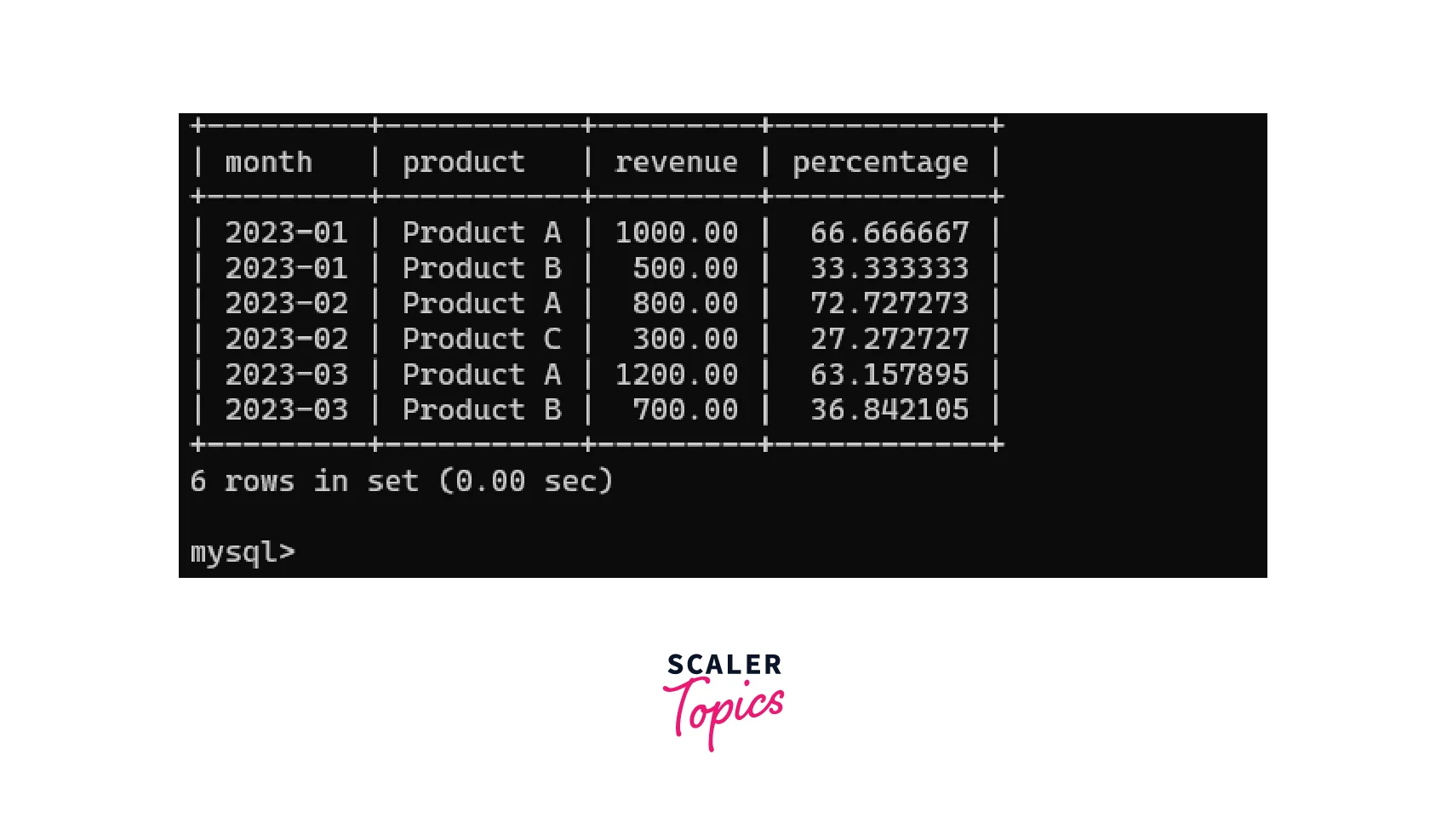
It shows the total revenue generated by each product, broken down by month. It also includes a column that shows the percentage of total revenue generated by each product, based on the revenue generated by all products in that month. The output will be sorted by month and by the percentage of revenue generated by each product within that month, in descending order.
MySQL Recursive CTE Example
An example of how Recursive Common Table Expressions (Recursive CTEs) can be used in MySQL:
Suppose you have a table with a hierarchical structure, such as an organizational chart with columns "employee_id", "manager_id", and "name". You want to create a report that lists all employees and their managers in a hierarchical order, with each employee's manager indented based on their level in the hierarchy. You can use a recursive CTE to achieve this:
Table - employees
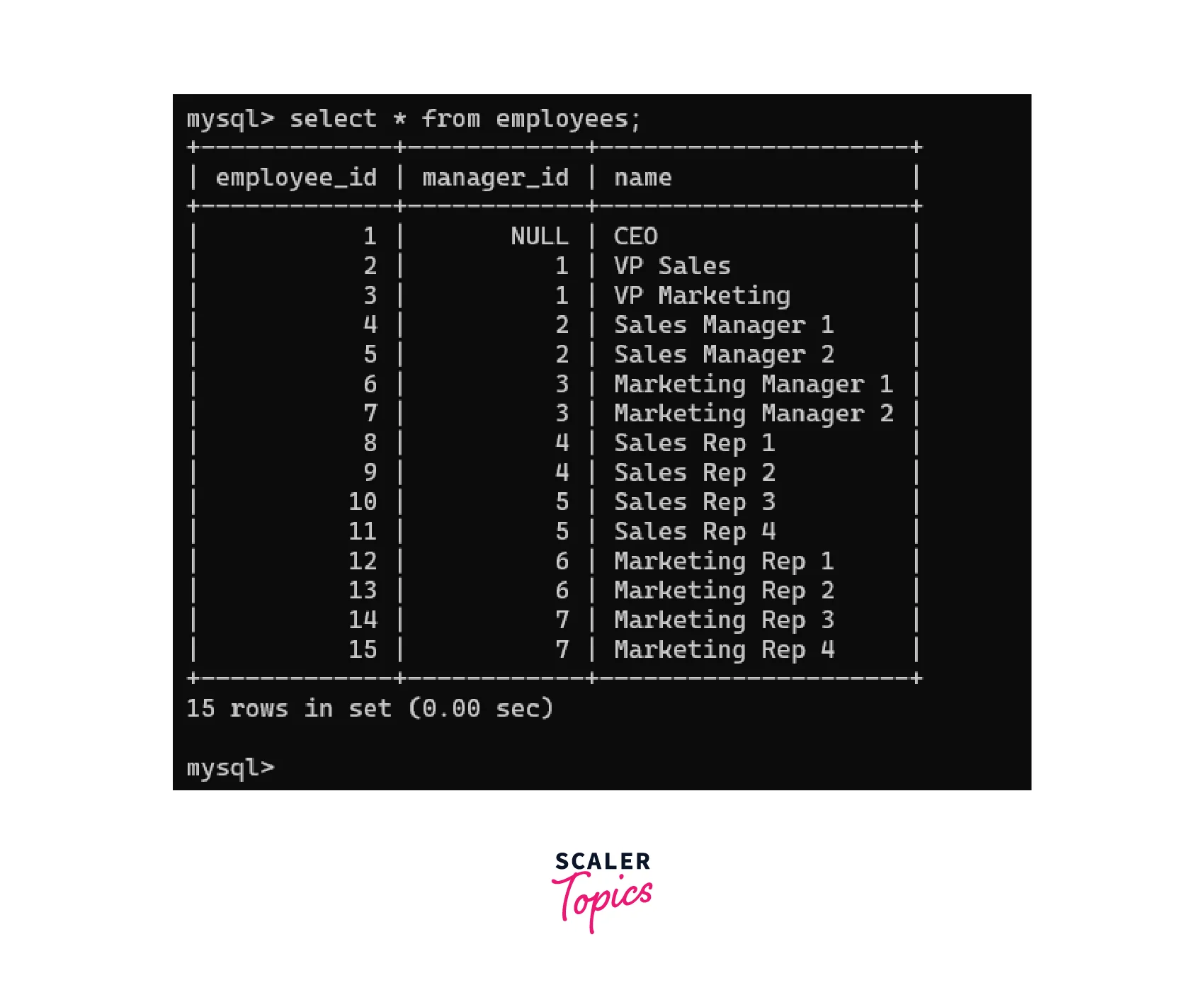
The Image depicts the table data of the following table employees.
Query -
Output -
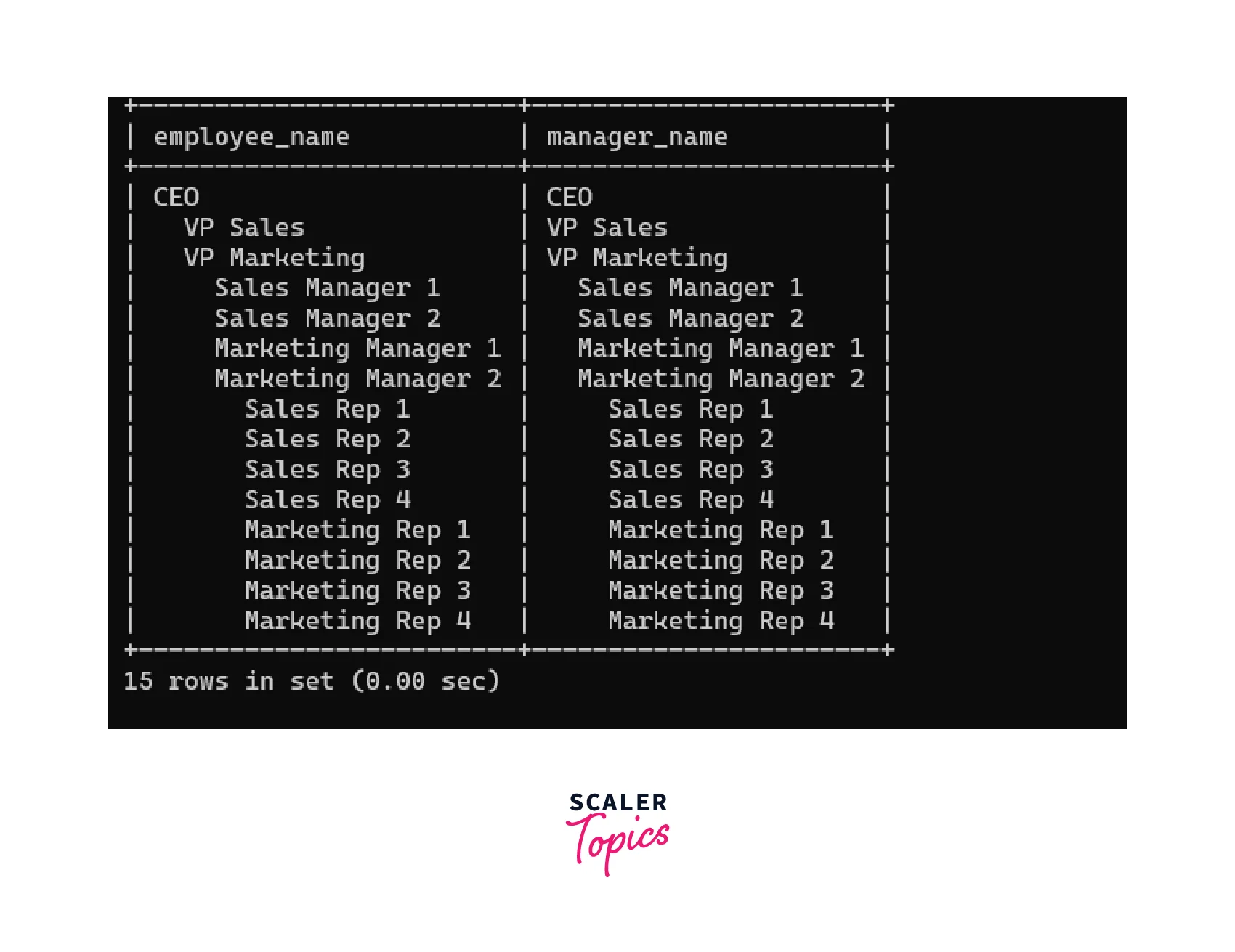
This recursive CTE first selects all employees with no managers and assigns them a level of 0. It then uses a UNION ALL operator to join the result set with a SELECT statement that refers to the CTE itself. This SELECT statement joins the "employees" table with the CTE using the "manager_id" and "employee_id" columns, respectively, and increments the level by 1.
The recursive CTE continues to refer to itself until no more records are returned, at which point the result set is returned to the main query. The main query selects the employee’s name and manager's name, indented based on their level in the hierarchy.
The WITH Clause Uses
The WITH clause, also known as the Common Table Expression (CTE) syntax, is a powerful feature in MySQL that enables you to define temporary named result sets, which can be referenced within a SQL statement. The WITH clause uses can simplify complex queries and improve the readability and maintainability of SQL code.
One of the main uses of the WITH clause is to define subqueries that are used multiple times within a query. By defining a CTE, you can avoid writing the same subquery multiple times, which can make your code easier to read and understand. In addition, CTEs can be used to define recursive queries, which allow you to traverse hierarchical data structures and perform complex calculations.
Another use of the WITH clause is to break down complex queries into smaller, more manageable parts. By defining CTEs, you can break a large query into smaller parts that can be easier to understand and debug. This can also make it easier to optimize queries, as you can analyze each CTE individually and identify areas for optimization.
The WITH clause can also be used to create self-contained, modular SQL code. By defining CTEs at the beginning of a query, you can create a modular structure that allows you to reuse parts of a query in other queries. This can make your code more flexible and adaptable to changing requirements, as you can easily reuse parts of a query without having to rewrite them from scratch.
Benefits of Using CTE
Here are some of the benefits of using Common Table Expressions (CTEs) in MySQL:
- Simplify complex queries:
CTEs can be used to break down complex queries into smaller, more manageable parts. By defining CTEs, you can avoid writing complex subqueries multiple times, which can make your code easier to read and understand. - Improve query performance:
CTEs can help improve query performance by reducing the number of database scans required to execute a query. By defining a CTE, you can create a temporary table that can be used to store intermediate results, which can reduce the number of scans required to retrieve data. - Reuse code:
CTEs can be used to create modular SQL code that can be reused across multiple queries. By defining a CTE at the beginning of a query, you can create a self-contained module that can be used in other queries, making your code more flexible and adaptable. - Traverse hierarchical data:
CTEs can be used to traverse hierarchical data structures, such as organizational charts or product categories. By defining a recursive CTE, you can traverse the hierarchy and perform complex calculations on the data. - Simplify debugging:
CTEs can help simplify debugging by breaking a complex query into smaller parts. By defining CTEs, you can analyze each part of the query individually, making it easier to identify and fix errors. - Improve code readability:
CTEs can improve the readability of your SQL code by providing a clear and concise way to define temporary named result sets. By using descriptive names for your CTEs, you can make your code easier to read and understand.
Conclusion
- Common Table Expressions CTE in MySQL provides a way to define temporary named result sets that can be referenced within a SQL statement.
- CTEs can simplify complex queries, improve performance, and create modular SQL code that can be reused across multiple queries.
- CTEs can be used to break down complex queries, traverse hierarchical data structures, and improve code readability.
- The WITH clause is used to define CTEs in MySQL, and can be used to create self-contained modules that can be reused across multiple queries.
